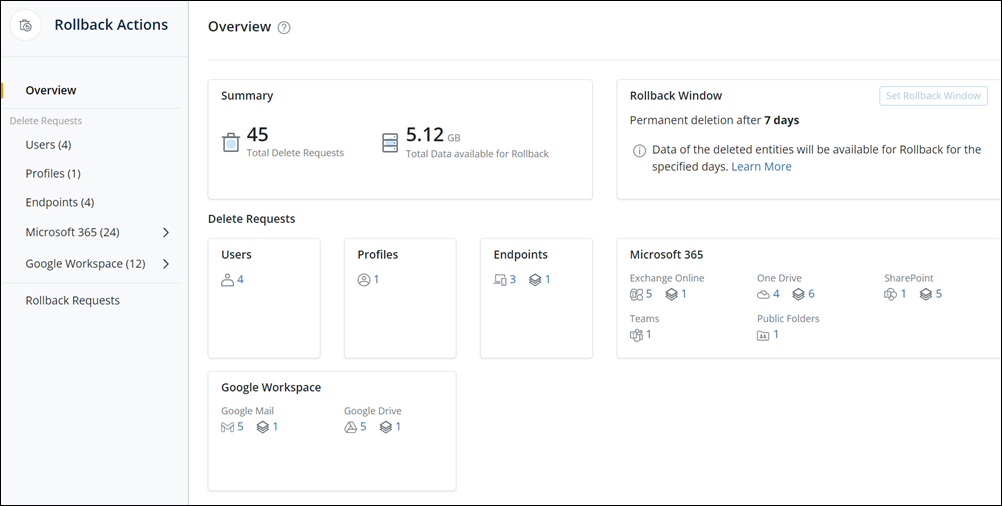Rollback deleted entities
All the entities deleted within a rollback window are available for rollback. Each delete action (can include multiple entities) corresponds to a delete request.
You can choose to rollback:
-
Multiple delete requests at the same time
-
All entities in a single delete request
-
Selective entities from a single delete request
Use case
Let’s say you have configured the rollback window for seven days on 1st January and on 8th January, a rogue administrator deletes 10 users at one time. A single delete request is created for all 10 users. The delete request details will contain information about all those users. Here, you can choose to rollback some or all of the users, or you can rollback another delete request with this delete request; a single rollback request will be created.
View deleted entities
The following views are available to help you to understand your data deletes before you perform a rollback:
-
Deletion summary of all the workloads
-
List of delete requests
-
Details of each delete request
Note: Only the entities with active delete requests are listed in the left navigation. For example, if there are no user deletion requests, the Users category will not be displayed in the left navigation.
To view a deletion summary of all the workloads you are protecting
The Rollback Action’s Overview page provides a deletion summary in the following cards
-
Summary: View information of total delete requests and the corresponding data size in bytes available for rollback.
-
Delete Requests: View the number of delete requests available for rollback for each entity type.

To view the delete requests listing
All the delete requests are listed on the respective Delete Requests page of each entity type.
One delete request is created for all the entities deleted at one time. For example, if you delete 10 Endpoints devices in a single delete action, one delete request is created.
The listing page provides the following information:

|
Column |
Description |
|---|---|
|
Delete Request ID |
Identifier for your delete request that you can use for tracking and troubleshooting. Click on an ID to view the delete request details. |
|
Delete Date |
Date on which the delete was performed. |
|
Entity Type |
Name of the entity that was deleted. The entity be any one of the following based on the selection:
|
|
Deleted By |
Name of the Administrator who performed the delete. |
|
Permanent Delete Date |
Date after which the entity will not be available for rollback and will be permanently deleted. |
|
Reason for Deletion |
Reason the administrator had provided while performing the delete. |
To view the details of each delete request
On the Delete Request listing page click on the Delete Request ID to view the details.
The Delete Request Details page provides the following information.

-
Summary: This section provides information about the delete request
-
Details of entities: This section provides details of all the entities that were deleted as part of the delete request.
Perform a rollback
-
On the Druva Cloud Platform dashboard, click Rollback Actions.
-
In the left pane, select the entity type whose entities you want to roll back.
-
On the Delete Requests listing page, you can perform the following:
-
Select one or multiple delete requests to roll back all the associated entities > Click Rollback.

-
Click the Delete Request ID > In the Details section, select the entities you want to rollback > Click Rollback.

-
-
Confirm the action to begin the rollback.
You can identify the Delete Request based on the details provided in the Delete Date, Deleted by or Reason for Deletion columns. You can also confirm the delete request by clicking on the ID to view deleted all the entities that were deleted as part of the delete request.
-
In the left pane, click Rollback Requests to monitor the progress.
After the rollback is successful, the entity is listed on its corresponding listing page and will be in its original state.
You can also view the audit trails of the rolled-back entity from the respective entities console.

